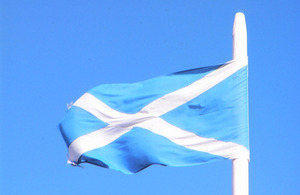Treasury analysis shows £1.6 billion funding gap in Scottish independence White Paper
The transparent analysis, which is consistent with the Autumn Statement 2013 forecasts and Budget methodology, has been published in full.

Scottish flag
The Scottish taxpayer faces a bill of £1.6 billion per year – the combined annual budget of the Police Scotland and the Scottish Fire and Rescue Service – to meet the costs of just three of the unfunded policy commitments in the Scottish government’s White Paper for independence, new Treasury analysis shows.
The transparent analysis, which is consistent with the Autumn Statement 2013 forecasts and HMT Budget methodology, has been published in full today by the Chief Secretary to the Treasury Danny Alexander.
It includes the costs of the Scottish Government’s proposals to:
- provide 1,140 hours per year of childcare to all children from one year old to school age (phased in during the first two Parliaments of an independent Scotland)
- cut Air Passenger Duty (APD) by 50%
- cut corporation tax by up to three percentage points
Because of insufficient detail put forward in the White Paper the £1.6 billion total does not include the costs of the Scottish Government’s proposals to:
- extend the halving of APD to full abolition
- increase the National Insurance Employment Allowance
- return Royal Mail in Scotland to public ownership
- consider reducing the state pension age
Danny Alexander said:
I am today publishing analysis that shows the Scottish Government would need to find £1.6 billion a year in higher taxes or spending cuts to fund just some of the additional commitments set out in the White Paper. This is equivalent to the combined annual budgets of Police Scotland and the Scottish Fire and Rescue Service.
The reality is that the White Paper shows nothing about how they would pay for these commitments. The Scottish Government cannot claim it is going to spend what it will not have.
The real choice next year is between unfunded promises that ignore the realities of being a new and separate country or an economic, political and social union – in the UK – that has stood the test of time. I believe we are better together and I look forward to continuing to make that case in 2014.
The analysis published today would add to the fiscal challenge facing an independent Scotland, which recent research from the IFS highlighted could – even on the most optimistic scenario – involve an 8 percentage point increase in the basic rate of income tax in an independent Scotland, which is equivalent to an average £1,000 increase for every basic rate taxpayer.
The analysis – and the White Paper’s failure to address the sustainability of an independent Scotland’s public finances – also comes against the back-drop of the independent Office for Budget Responsibility revising down the forecast for North Sea oil and gas receipts in their forecast for this month’s Autumn Statement.
Danny Alexander added:
The OBR has revised down North Sea oil and gas forecasts by £3½ billion over the next three years. Instead of needing to cut spending – as we would have to as an independent country – the Scottish government will actually see its budget rise by more than £300 million over the same period.
This shows the very real benefit that the UK’s integrated economy and public finances brings to Scotland year-in and year-out.
Photo by Khaalis on Flickr. Used under creative commons.